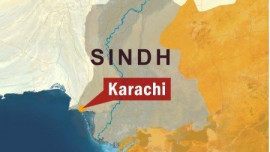
KARACHI: On the surface, Karachi is a city that suffers. It has been wracked by pollution and target killings. Its industries, that drive the very machinery of our national economy, dump filth and disease into the air and our water. Ask anyone who lives here and they will tell you that no matter how much they may love the city, getting away from it is just as important. Options are limited if you can’t afford foreign vacations. But happily, underneath Karachi’s surface lies a beautiful world that many of us never explore.
That world lies underwater. And the best way to get to it is by scuba diving.
Unfortunately, the blue lagoons, very much a part of Karachi’s natural beauty, are not known for water sports and recreation simply because most people don’t know they exist. But you can find lots to do along the coast, from whale watching to snorkelling.
There are many snorkelling and scuba diving clubs, trainers and tours that are certified by the Professional Association of Diving Instructors, which is the largest international recreational diving membership and diving training organisation.
Training lasts from 12 hours to seven days, depending on the course, age and experience of the learner. “We’ve had children from age 10 to adults from 45 years old. Our members range from photographers to businessmen,” says Aatif Malik, owner of the Indus Scuba Club. For him, the response is limited but definitely more than he had expected before embarking on this business venture.
The courses cost from Rs2,500 to Rs30,000. The Karachi Scuba Diving Centre trains the police and rescue officials and helps researchers too. The only downside is that seemingly endless lists of equipment are needed: wet suits, masks, goggles, fins, tanks. The kit is expensive but you can rent it from the shops located at most of the clubs and training centres.
Karachi’s diving is also very safe mainly because there are hardly any sharks. The trainers are licenced and they have lifeguards for every tour. The trainers assure that from your first plunge to your last gasp out of the water, it’s all good, as professional trainers always escort amateurs.
The instructors teach you everything you need to know about scuba diving and snorkelling but you need to know how to swim and tread water before your enrol in the training programme. The courses start for children who are at least 10 years old. The basic training involves introductory aqua missions, filling out-of-water activity books and training to dive to 12 metres deep under water. This preparation also includes modules and tutorials.
“The best season for diving is January to March when the underwater beauty is at its peak,” says Yousuf Ali, director operations at the Karachi Scuba Diving Centre.
If you’re lucky, you can catch a whale passing by Churna Island. November and December are the best months for whalewatching. Unfortunately, very little is known about the family of whales that passes through the continental shelf and so the visits cannot be timed.
People can also go cavern diving that involves cave navigation, line protocols and training for emergencies. Deep-sea diving entails going 60 to 130 feet down, while the underwater navigator course trains you for underwater mapmaking and teaches you to navigate with or without a compass.
A very interesting programme is the wreck diver course in which you learn techniques of exploring shipwrecks underwater.
You can also receive training for ice diving, digital underwater photography and night diving.
So if you’re tired of Karachi on the surface, don’t forget there is plenty that lies underneath.
Published in The Express Tribune, July 20th, 2010.


































































COMMENTS (1)
Comments are moderated and generally will be posted if they are on-topic and not abusive.
For more information, please see our Comments FAQ